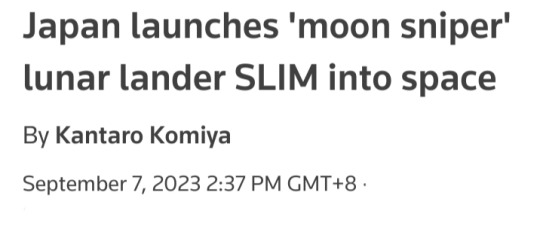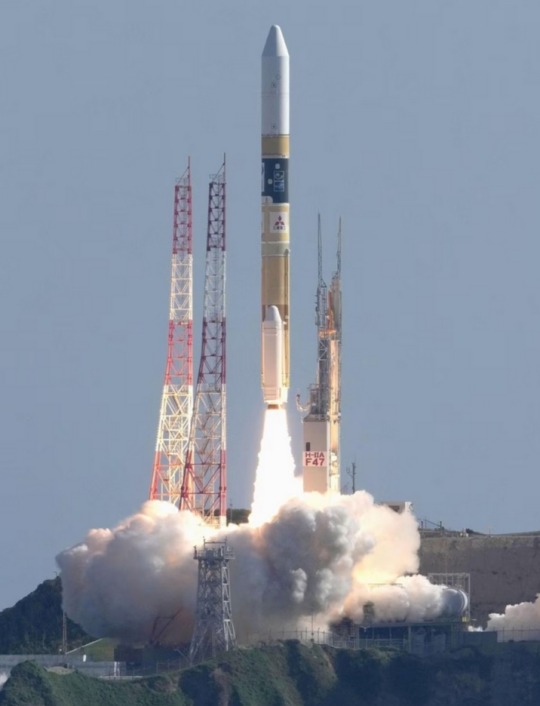#ispace
Explore tagged Tumblr posts
Text



Tenacious (2025) by ispace, Japan. The Resilience lander is due to touchdown on the moon's "Sea of Cold" on Thursday June 5, 2025. Resilience is ispace's latest lunar lander using the same design as the failed Hakuto-R Mission 1. Weighing just 5kg, the Tenacious rover has a carbon fibre-reinforced plastic frame and includes a forward-mounted high-definition camera and a small shovel to collect samples for imaging by the camera. One noteworthy feature mounted on the chassis of the rover is an artwork by Mikael Genberg called the "Moonhouse"; a tiny model of an iconic Swedish red house.
"The Moon House will be the first site-specific artwork on the Moon created at the moment the House is installed on the Moon. The moon has always stimulated man's imagination with its cold beauty. The knowledge that there is a red house with white trim in the middle of the 'magnificent desolation', as one of the first lunar travelers put it, has the potential to change the whole picture. No matter what thoughts and feelings the lunar house generates in each of us, it leaves no one untouched." – Mikael Genberg.
UPDATE: "Resilience, ispace's second lunar lander, had problems measuring its distance to the surface and could not slow its descent fast enough, the company said, adding it has not been able to communicate with Resilience after a likely hard landing." – Reuters June 6, 2025.
8 notes
·
View notes
Text

The moon casts a shadow over Australia during a total solar eclipse, as the Earth rises over the moon's horizon. Days before Japan's Hakuto-R lunar lander crashed into the moon's surface on April 25, 2023, it snapped this gorgeous picture of our planet.
(Image credit: ispace)
#ispace#photographer#moon#earth#space#astronomy#science#australia#total solar eclipse#japan#hakuto-r lunar lander#nature
33 notes
·
View notes
Text


TOKYO, Sept 7 (Reuters) - Japan launched its lunar exploration spacecraft on Thursday aboard a homegrown H-IIA rocket, hoping to become the world's fifth country to land on the moon early next year.
Japan Aerospace Exploration Agency (JAXA) said the rocket took off from Tanegashima Space Center in southern Japan as planned and successfully released the Smart Lander for Investigating Moon (SLIM).
Unfavourable weather led to three postponements in a week last month.
Dubbed the "moon sniper," Japan aims to land SLIM within 100 metres of its target site on the lunar surface.
The $100-million mission is expected to start the landing by February after a long, fuel-efficient approach trajectory.
"The big objective of SLIM is to prove the high-accuracy landing ... to achieve 'landing where we want' on the lunar surface, rather than 'landing where we can'," JAXA President Hiroshi Yamakawa told a news conference.

The launch comes two weeks after India became the fourth nation to successfully land a spacecraft on the moon with its Chandrayaan-3 mission to the unexplored lunar south pole.
Around the same time, Russia's Luna-25 lander crashed while approaching the moon.
Two earlier lunar landing attempts by Japan failed in the last year.
JAXA lost contact with the OMOTENASHI lander and scrubbed an attempted landing in November.
The Hakuto-R Mission 1 lander, made by Japanese startup ispace (9348.T), crashed in April as it attempted to descend to the lunar surface.

SLIM is set to touch down on the near side of the moon close to Mare Nectaris, a lunar sea that, viewed from Earth, appears as a dark spot.
Its primary goal is to test advanced optical and image processing technology.
After landing, the craft aims to analyse the composition of olivine rocks near the sites in search of clues about the origin of the moon. No lunar rover is loaded on SLIM.
Thursday's H-IIA rocket also carried the X-Ray Imaging and Spectroscopy Mission (XRISM) satellite, a joint project of JAXA, NASA and the European Space Agency.
The satellite aims to observe plasma winds flowing through the universe that scientists see as key to helping understand the evolution of stars and galaxies.

Mitsubishi Heavy Industries (7011.T) manufactured the rocket and operated the launch, which marked the 47th H-IIA rocket Japan has launched since 2001, bringing the vehicle's success rate close to 98%.
JAXA had suspended the launch of H-IIA carrying SLIM for several months while it investigated the failure of its new medium-lift H3 rocket during its debut in March.
Japan's space missions have faced other recent setbacks, with the launch failure of the Epsilon small rocket in October 2022, followed by an engine explosion during a test in July.
The country aims to send an astronaut to the moon's surface in the latter half of the 2020s as part of NASA's Artemis programme.
https://www.reuters.com/technology/space/japan-launches-rocket-carrying-moon-lander-slim-after-three-delays-2023-09-06/
youtube
Japan launches 'Moon Sniper' mission | AFP
7 September 2023
Japan's "Moon Sniper" mission blasted off Thursday as the country's space programme looks to bounce back from a string of recent mishaps, weeks after India's historic lunar triumph.
#H-IIA rocket#Japan#lunar exploration spacecraft#SLIM#moon sniper#Japan Aerospace Exploration Agency (JAXA)#Tanegashima Space Center#Smart Lander for Investigating Moon#Hiroshi Yamakawa#Hakuto-R Mission 1 lander#ispace#Mare Nectaris#X-Ray Imaging and Spectroscopy Mission (XRISM) satellite#JAXA#NASA#European Space Agency#Mitsubishi Heavy Industries#Artemis#space#space rocket#Youtube#Chandrayaan-3 mission#Luna-25 lander#India#Russia#moon#moon landing
25 notes
·
View notes
Text

i love my new oc i designed
9 notes
·
View notes
Text
暴落のispaceは逆転テンバガーあるか
第1章:夢から現実へ―ispaceという存在 ispaceは2010年に東京で設立された日本の宇宙ベンチャー企業です。 社長の袴田武史氏は、航空宇宙工学の専門家であり、Google Lunar X Prize(民間による月面探査競技)への挑戦から出発しました。 彼の掲げたビジョンは明確です――「月に1,000人が暮らす未来を実現する」。 この夢は、国家による宇宙開発から民間主導へと移行する転換点でもあります。 ispaceはその先陣を切る存在として注目されてきました。 — 第2章:Mission 1とその成果 ispaceが初めて月面着陸に挑んだのは、2022年のMission…
0 notes
Text
Fabricado en plástico reforzado con fibra de carbono y con cuatro ruedas, el rover de ispace, de fabricación europea y llamado Tenacious, incorpora una cámara de alta definición para explorar la zona y una pala para recoger tierra lunar para la NASA.
0 notes
Text
Итоги японской лунной миссии Hakuto-R M2: результаты, фотографии и видео
В этой статье рассказано о полёте Hakuto-R M2 к Луне, нахождении на её орбите, неудачном прилунен... Читать дальше »
0 notes
Text
.@TLPN_Official
"Watch LIVE as #iSpace attempts to land the #Hakuto_R #lunarlander on its second ever mission to the #moon! "
#Japan L-04:43:00
https://www.youtube.com/live/DW5eXX0PU0g?si=hf1VDQMEP8m8tHUV
0 notes
Text
Robotic Lunar Lander Launched From KSC Set To Land Today
A lunar lander that launched from KSC in January will attempt to land on the surface of the moon this afternoon. On January 15, 2025, at 1:11 a.m. EST, Japanese space company ispace launched its RESILIENCE lunar lander aboard a SpaceX Falcon 9 rocket from Kennedy Space Center in Florida. This mission, known as Hakuto-R Mission 2, marks ispace’s second attempt to achieve a soft landing on the…
#ispace#landing attempt#Lunar Lander#RESILIENCE landing attempt today#Titusville#what time is the RESILIENCE landing
0 notes
Text
What time will Japan's ispace Resilience probe land on the moon on June 5?
(Image credit: ispace) The Japanese company ispace is hoping to make some space history on Thursday (June 5), when it attempts to land a private spacecraft on the moon. But if you’re hoping to watch it live, you’ll need to know when and where to tune in. The Resilience lander, the second-ever private ispace lunar probe, is on track for a midday landing in the northern reaches of the moon.…
0 notes
Text
0 notes
Link
Astronomy Daily - The Podcast: S04E39 In this episode of Astronomy Daily, host Anna takes you on an exhilarating exploration of the latest happenings in the world of space exploration. From Blue Origin's ambitious new rocket plans to the thrilling journey of ispace's Resilience lunar lander, this episode is packed with captivating stories that will fuel your cosmic curiosity. Highlights: - Blue Origin's New Glenn Rocket Update: Discover the latest developments regarding Blue Origin's New Glenn rocket as the company prepares for its second launch. Learn about the challenges faced during the first flight and the significant restructuring within the company aimed at improving efficiency and focus. - Ispace's Resilience Lunar Lander: Follow the exciting progress of ispace's Resilience lander as it approaches a historic moon landing attempt. Understand the innovative fuel-saving trajectory it is taking and the scientific payloads it carries, including the Micro Rover. - James Webb Space Telescope's Role in Asteroid Tracking: Delve into how the James Webb Space Telescope is set to play a crucial role in assessing the potential impact risk of asteroid 2024 YR4, which has raised concerns among astronomers worldwide. - SpaceX's Starship Preparations: Get the latest on SpaceX's preparations for their eighth Starship test flight, including successful engine tests and modifications that are being made in anticipation of the upcoming launch. - Remarkable Spacecraft Resurrections: Be inspired by incredible stories of spacecraft that have defied the odds and returned from the brink of oblivion, showcasing the resilience of technology and the spirit of exploration. For more cosmic updates, visit our website at astronomydaily.io. Join our community on social media by searching for #AstroDailyPod on Facebook, X, YouTubeMusic, and TikTok. Don't forget to subscribe to the podcast on Apple Podcasts, Spotify, iHeartRadio, or wherever you get your podcasts. Thank you for tuning in. This is Anna signing off. Until next time, keep looking up and stay curious about the wonders of our universe. 00:00 - Welcome back to Astronomy Daily 01:02 - Blue Origin's New Glenn updates 05:30 - Ispace's Resilience lunar lander progress 10:15 - James Webb Telescope and asteroid 2024 YR4 14:00 - SpaceX's Starship preparations 18:20 - Stories of spacecraft resurrections 25:00 - Conclusion and upcoming content ✍️ Episode References Blue Origin's New Glenn Rocket [Blue Origin](https://www.blueorigin.com) Ispace's Resilience Lunar Lander [Ispace](https://www.ispace-inc.com) James Webb Space Telescope Insights [James Webb](https://www.nasa.gov/webb) SpaceX's Starship Updates [SpaceX](https://www.spacex.com) Spacecraft Resurrections Stories [Spacecraft Resurrections](https://www.nasa.gov) Astronomy Daily [Astronomy Daily](http://www.astronomydaily.io)
#2024#asteroid#astrodailypod#blue#exploration#glenn#ispace#james#lander#lunar#new#origin#resilience#rocket#space#spacex#starship#telescope#webb#yr4
0 notes
Text
SciTech Chronicles. . . . . . . . . . . . . . . . . . . . . . . . . . . . . .Jan 17, 2025
#Xeon#anesthetic#neuroprotectant#TBI#Alzheimer's#Mouse#Clinical-trials Firefly#iSpace#CLPS#Blue-Ghost#Resilience#Birth-rate#pets#obligations#competition#pressures#affordable#mortgage#Mayors#2008#homebuilders#qubit @quantum#antimony#Schrödinger#error-correction
0 notes
Text
株式会社ispace(東京都中央区、代表取締役CEO & Founder 袴田武史、証券コード:9348)は、2025年1月15日(水)午後3時11分(日本時間)、米国フロリダ州ケネディ宇宙センターからSpaceX社のFalcon 9ロケットを使用してMission 2 “SMBC x HAKUTO-R VENTURE MOON”のRESILIENCEランダーを打ち上げました。さらに、同日午後4時44分(日本時間)、ロケットからの分離を確認し、Mission 2マイルストーンのSuccess 2を達成した���とをお知らせいたします。
0 notes
Text

This photo provided by The Moonhouse project and taken in September 2024 at the ispace facilities in Japan, shows a little red model house created by artist Mikael Genberg and scheduled to launched into space on a Falcon 9 rocket from Cape Canaveral in Florida on Wednesday, Jan. 15, 2025. (ispace mission 2 via AP) By The Associated Press | [email protected] PUBLISHED: January 15, 2025 at 6:00 AM EST
#little red house#moonhouse#ispace#japan#falcon 9#cape canaveral#space#mission to the moon#nasa#moon landing#rocket#genberg#moon
0 notes
Text

A little while ago, ispace's Hakuto-R2 Resilience and Firefly Aerospace's Blue Ghost Moon landers blasted off atop a Falcon 9 rocket from Cape Canaveral. After about 1 hour and 5 minutes, Blue Ghost successfully separated from the rocket's upper stage, and about 27 minutes later, Resilience separated as well. The two landers will travel on very different routes to attempt to land on the Moon a few months apart. This is ispace's second mission, after the first failed on April 25, 2023.
0 notes